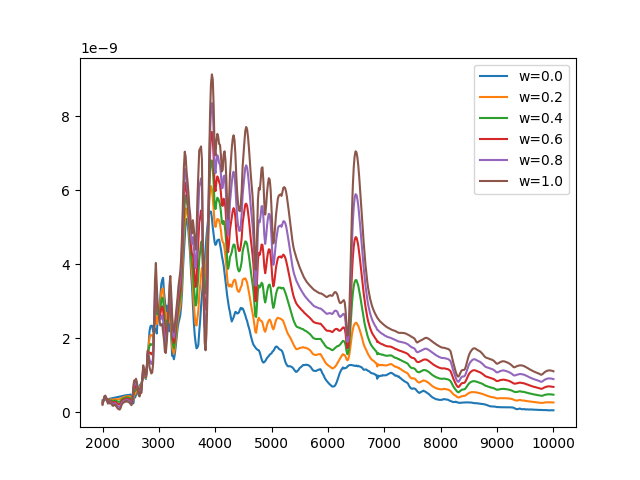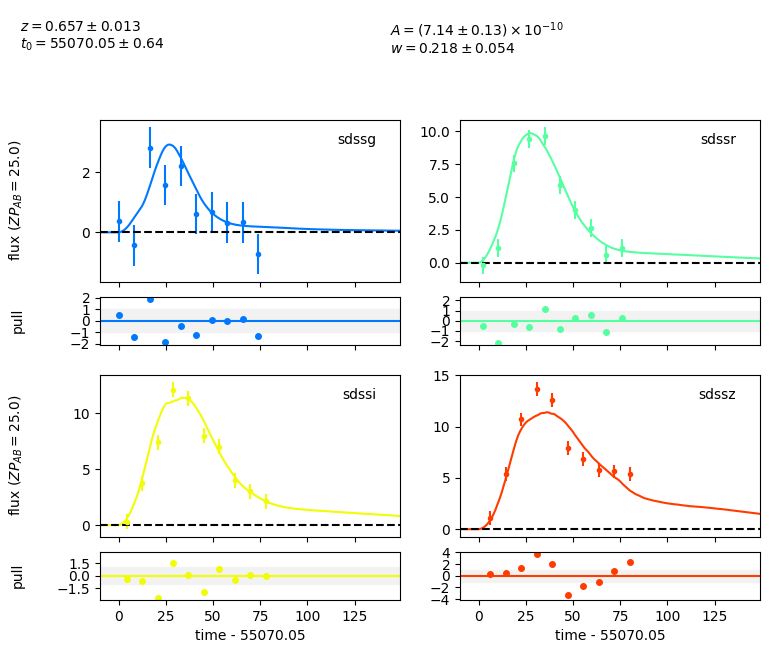Note
Go to the end to download the full example code
Creating a new Source class¶
Extending sncosmo with a custom type of Source.
A Source is something that specifies a spectral timeseries as
a function of an arbitrary number of parameters. For example, the SALT2
model has three parameters (x0, x1 and c) that determine a
unique spectrum as a function of phase. The SALT2Source class implements
the behavior of the model: how the spectral time series depends on those
parameters.
If you have a spectral timeseries model that follows the behavior of one of
the existing classes, such as TimeSeriesSource, great! There’s no need to
write a custom class. However, suppose you want to implement a model that
has some new parameterization. In this case, you need a new class that
implements the behavior.
In this example, we implement a new type of source model. Our model is a linear
combination of two spectral time series, with a parameter w that
determines the relative weight of the models.
import numpy as np
from scipy.interpolate import RectBivariateSpline
import sncosmo
class ComboSource(sncosmo.Source):
_param_names = ['amplitude', 'w']
param_names_latex = ['A', 'w'] # used in plotting display
def __init__(self, phase, wave, flux1, flux2, name=None, version=None):
self.name = name
self.version = version
self._phase = phase
self._wave = wave
# ensure that fluxes are on the same scale
flux2 = flux1.max() / flux2.max() * flux2
self._model_flux1 = RectBivariateSpline(phase, wave, flux1, kx=3, ky=3)
self._model_flux2 = RectBivariateSpline(phase, wave, flux2, kx=3, ky=3)
self._parameters = np.array([1., 0.5]) # initial parameters
def _flux(self, phase, wave):
amplitude, w = self._parameters
return amplitude * ((1.0 - w) * self._model_flux1(phase, wave) +
w * self._model_flux2(phase, wave))
… and that’s all that we need to define!: A couple class attributes
(_param_names and param_names_latex, an __init__ method,
and a _flux method. The _flux method is guaranteed to be passed
numpy arrays for phase and wavelength.
We can now initialize an instance of this source from two spectral time series:
#Just as an example, we'll use some undocumented functionality in
# sncosmo to download the Nugent Ia and 2p templates. Don't rely on this
# the `DATADIR` object, or these paths in your code though, as these are
# subject to change between version of sncosmo!
from sncosmo.builtins import DATADIR
phase1, wave1, flux1 = sncosmo.read_griddata_ascii(
DATADIR.abspath('models/nugent/sn1a_flux.v1.2.dat'))
phase2, wave2, flux2 = sncosmo.read_griddata_ascii(
DATADIR.abspath('models/nugent/sn2p_flux.v1.2.dat'))
# In our __init__ method we defined above, the two fluxes need to be on
# the same grid, so interpolate the second onto the first:
flux2_interp = RectBivariateSpline(phase2, wave2, flux2)(phase1, wave1)
source = ComboSource(phase1, wave1, flux1, flux2_interp, name='sn1a+sn2p')
Downloading http://c3.lbl.gov/nugent/templates/sn1a_flux.v1.2.dat.gz [Done]
Downloading http://c3.lbl.gov/nugent/templates/sn2p_flux.v1.2.dat.gz [Done]
We can get a summary of the Source we created:
print(source)
class : ComboSource
name : 'sn1a+sn2p'
version : None
phases : [0, .., 90] days
wavelengths: [1000, .., 25000] Angstroms
parameters:
amplitude = 1.0
w = 0.5
Get a spectrum at phase 10 for different parameters:

The w=0 spectrum is that of the Ia model, the w=1 spectrum is that of the IIp model, while intermediate spectra are weighted combinations.
We can even fit the model to some data!
model = sncosmo.Model(source=source)
data = sncosmo.load_example_data()
result, fitted_model = sncosmo.fit_lc(data, model,
['z', 't0', 'amplitude', 'w'],
bounds={'z': (0.2, 1.0),
'w': (0.0, 1.0)})
sncosmo.plot_lc(data, model=fitted_model, errors=result.errors)

<Figure size 780x670 with 8 Axes>
The fact that the fitted value of w is closer to 0 than 1 indicates that the light curve looks more like the Ia template than the IIp template. This is generally what we expected since the example data here was generated from a Ia template (although not the Nugent template!).
Total running time of the script: ( 0 minutes 2.662 seconds)